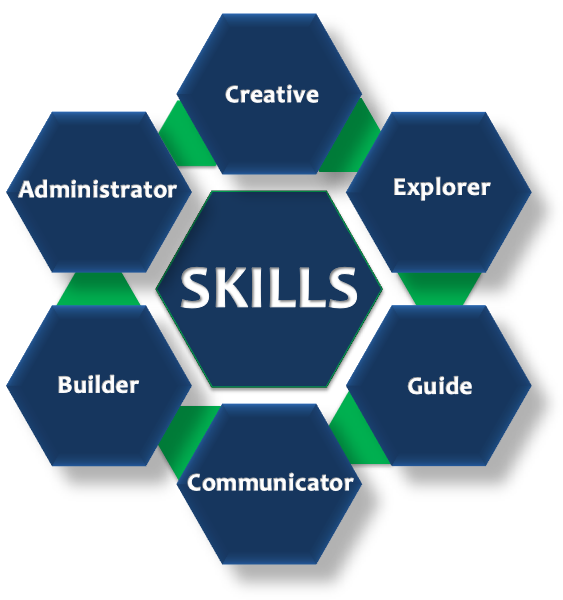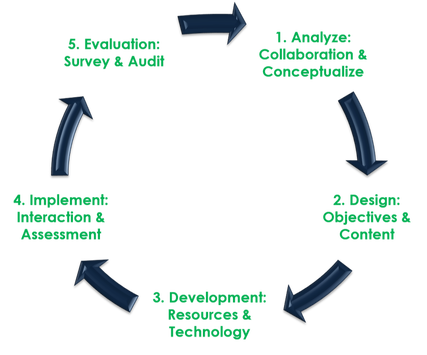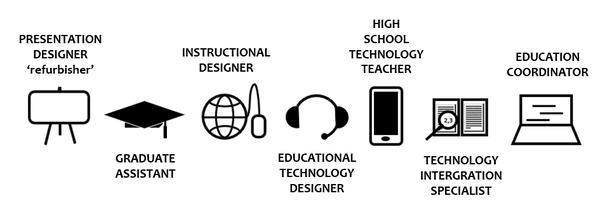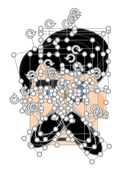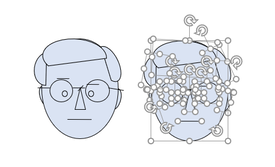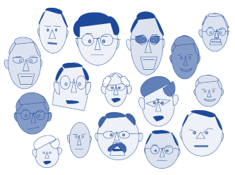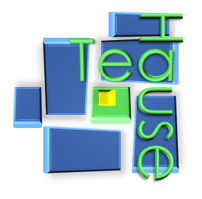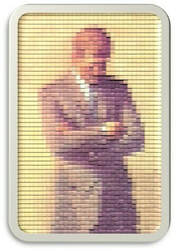KMN DESIGN
Instructional Design, Learning Platform Administrator & eLearning (EdTech) Experience
Certifications
Quality Matters: Higher Ed. - Applying the Quality Matters Rubric (APPQMR)
Quality Matters: Higher Ed. - Designing Your Online Course (DYOC)
Quality Matters: Higher Ed. - Designing Your Online Course (DYOC)
Google: Certified Educator 1
In 2008, I transitioned from my full-time teaching role to pursue a career dedicated to integrating technology and learning. Witnessing the rapid adaptation of my students to technology, I recognized the imperative need to center my focus on technology for continued success as an educator. Since earning my master's degree in educational technology from James Madison University, I have held various positions in educational technology. These diverse experiences have equipped me with valuable skills across a spectrum of technologies, learner profiles, and educational environments. -KMN
Instructional Design Skills
I am confident that my skills, experiences, and online knowledge position me well to excel in the challenging responsibilities of various instructional design and modern education roles.
CreativeAs a designer and teacher, I developed inventive education resources using the most creative methods and tools.
ExplorerResearched traditional adult learning theories (ADDIE, SAM, SAMR, Kemp) and successfully implemented them into the design process.
GuideEffectively guided a number of diverse subject matter experts to condense and organize their technical knowledge into learning platforms.
CommunicatorProfessional communicator, established by over ten years of teaching experience, along with several years of higher education involvement.
BuilderDeveloped over 25 comprehensive courses, often with limited resources and timelines. Contributed to development of hundreds of courses and training resources.
AdministratorAdministered several educational learning and assessment systems and often managed all technical support.
|
Technical Skills
|
Learning Management Systems:
ANGEL Blackboard Learn Schoology Plato Canvas (limited) Learning Analytics Systems: Renaissance Learning STAR Math STAR Reading Assessment Management Systems: Tk20 (now watermark) |
Microsoft:
Office 365 Adobe: Creative Suite eLearning: iSpring Articulate Captivate *SCORM proficient |
Online Assessment Support:
American Institutes for Research (AIR) Partnership for Assessment of Readiness for College & Careers (PARCC) Ohio Graduation Test (OGT) Instructional Design Models: ADDIE SAM SAMR Kemp Assessment Maker Tools: Respondus |
Learning & Design
Theories
My online design process draws inspiration from various models, particularly ADDIE and Kemp. The SAM model becomes imperative for expeditious content development needs. Leveraging my background as a K-12 educator, I also integrate the SAMR model to guarantee the adaptability of content for implementation in traditional classroom settings.
Irrespective of the chosen model for content design, I regard the evaluation step as paramount. A thorough evaluation is pivotal in gauging goal achievement and identifying necessary revisions for content enhancement. I approach content design with the understanding that it requires continual, insightful revision to ensure its ongoing improvement.
Irrespective of the chosen model for content design, I regard the evaluation step as paramount. A thorough evaluation is pivotal in gauging goal achievement and identifying necessary revisions for content enhancement. I approach content design with the understanding that it requires continual, insightful revision to ensure its ongoing improvement.
Learning Theories:
As a contemporary educator, my influences span a diverse range of learning theories. In the K-12 realm, I draw inspiration from the works of Jean Piaget and Lev Vygotsky. I firmly believe that the insights provided by these theorists offer valuable perspectives for successful design and adult education.
Jean Piaget
Piaget's theories are instrumental in understanding human development, with his concept of metacognition holding significant relevance in adult learning. According to Piaget, metacognition represents the final stage of human development, characterized by the development of higher-order thinking skills. In the context of adult learning, I suggest that professional skills also undergo a similar developmental pattern, and many inexperienced workers may lack the professional metacognitive stage.
A proficient designer recognizes the necessity to foster the development of higher-order professional skills and strategically designs content to advance these skills in adult learners.
A proficient designer recognizes the necessity to foster the development of higher-order professional skills and strategically designs content to advance these skills in adult learners.
Lev Vygotsky
Vygotsky's Zone of Proximal Development (ZPD) proves to be a valuable framework for designing content tailored to adult learners. The ZPD concept aims to discern the skills a learner can execute independently and what they can achieve with the guidance of someone more knowledgeable in the activity. In the realm of adult training, this ZPD concept becomes pivotal for shaping content and individual goals, as well as establishing effective mentoring programs.
A skilled designer, cognizant of the ZPD concept, structures content to identify established skills and delineates pathways for advancing individual learning. This approach may involve well-developed content, mentoring programs, and effective structural knowledge management principles.
A skilled designer, cognizant of the ZPD concept, structures content to identify established skills and delineates pathways for advancing individual learning. This approach may involve well-developed content, mentoring programs, and effective structural knowledge management principles.
Design Theories:
It's evident that Malcolm Knowles and Richard Mayer significantly influence my design principles. Their perspectives and contributions serve as foundational pillars shaping the approach and methodology I employ in instructional design.
Malcolm KnowlesMalcolm Knowles's humanist theories on adult education hold the most significant impact on my design philosophy. His four principles for adult learning, as suggested, form the guiding framework that I apply in developing effective instructional designs.
Designing content guided by these four principles can elevate the modern educational experience, making it both proficient and efficient.
To delve deeper into educational and design theories, I invite you to explore the 'Instructional Design' page for additional information.
|
Richard MayerRichard Mayer’s 12 Principles of Multimedia Learning are the prevailing design resource.
|
Instructional Design Process
(Blooms', A.D.D.I.E. & SAMR)
While numerous instructional design theories exist (including ADDIE, SAM, SAMR, Kemp, Dick & Carey, Kirkpatrick), my expertise and influence are most pronounced in ADDIE and SAMR. It's worth noting that every successful design process initiates with well-crafted objectives, guided by the principles of Bloom's Taxonomy.
|
Instructional Design Experience
PRESENTATION DESIGNER...
‘PowerPoint Refurbisher’
PowerPoint
•Designed several PowerPoint presentations
•Designed several PowerPoint presentations
Graduate Student: ‘PowerPoint Refurbisher’
|
During my time as a graduate student at James Madison University, I took on the role of designing numerous PowerPoint presentations for both my peers and faculty members. I earned the moniker of "PowerPoint Refurbisher," as I was frequently called upon to enhance both the aesthetics and functionality of presentations.
|

My exploration revealed that PowerPoint facilitates the swift creation of substantial design resources, encompassing icons, simple graphics, page layouts, and even comprehensive packets. Over time, I honed my skills with PowerPoint, considering them invaluable assets for any design project. Despite the emergence of more contemporary graphic platforms such as Canva, I maintain a belief in PowerPoint's continued significance in various design processes and presentations. Nevertheless, I wholeheartedly embrace platforms like Canva, recognizing their collaborative features as exceptional resources for modern design processes.
Presentation Designer: ‘PowerPoint Refurbisher’
TMW Systems (now: Trimble)
- Designed the TMW Systems TransForum2009 PowerPoint Presentation
The 2009 TransForum conference marked my inaugural foray into professional design. Tasked with the assignment after a Graphic Designer was unable to fulfill the request, I successfully crafted a 111-slide presentation within a constrained time frame. The presentation seamlessly ran continuously at the conference, displayed across multiple projection screens.
2009 TransForum presentation (selected slides):
|
|
Given a 111-slide PowerPoint presentation laden with text but lacking a theme and imagery, I undertook the task with specific directives. The requirements included retaining the text, integrating corporate logos (TRANSFORUM2009), incorporating animated transitions judiciously (while avoiding an overly juvenile feel), and ensuring the automated presentation ran continuously. Through pragmatic instructional design choices, I believe I effectively addressed the product, the audience, and the medium's constraints. *Please Note: this was in 2009 and my skills have greatly advanced since then. However, this was deemed an impressive presentation at the time.
|
GRADUATE ASSISTANT
College of Education, James Madison University - Harrisonburg, Virginia
Assisted with the implementation of the TK20 assessment and accreditation software for James Madison’s College of Education Student Teaching program.
Assisted with the implementation of the TK20 assessment and accreditation software for James Madison’s College of Education Student Teaching program.
- TK20 Assessment and Accreditation Software Administrator role - tk20.jmu.edu
- Assisted with the development of TK20 support and training resources for the College of Education Student Teaching Program - Tk20 (now watermark)
- Created TK20 software assessment rubrics for the Student Teaching evaluations
- Maintained TK20 technology support of University Supervisors, Cooperating Teachers, and Student Teachers
Tk20 Support Resources:
|
|
As a graduate assistant, my design style took shape while I undertook the responsibility of identifying persistent technology issues within the Student Teaching Program. Every aspect, including formatting, colors, and content, underwent suggestions, reviews, revisions, and approvals by the Implementation Committee. While the images from that time reflect my initial development, they also symbolize the valuable lessons learned in collaboration, maintaining design consistency, and effective communication—crucial elements for fully optimizing technology and the design process.
|
INSTRUCTIONAL DESIGNER
Stark State College - North Canton, Ohio
Assisted with the development of the online education department (eStarkState).
Assisted with the development of the online education department (eStarkState).
- Assisted with the administration of the ANGEL Learning Management System for the entire college
- Led ANGEL Learning Management System training for students and faculty - online and classroom
- Created resources (synchronous/asynchronous) for instructors and student orientations
- Developed and administered training courses on several online teaching principles:
ANGEL Learning Management System,
ANGEL Training, Start-up Week ‘Boot Camp’,
Online Assessments,
Online Gradebook,
Online Student Expectations,
Online Student Engagement
Rich Media
ANGEL Training, Start-up Week ‘Boot Camp’,
Online Assessments,
Online Gradebook,
Online Student Expectations,
Online Student Engagement
Rich Media
- Provided ANGEL Learning Management System technical support (24/7)
- Utilized customer service software and support ticketing system Zendesk
- Collaborated with subject matter experts in the development of numerous online and blended courses
- Conducted analysis of training and online courses to ensure authentic learning and assessment
- Created resources (synchronous/asynchronous) for instructors and student orientation
- Collaborated with subject matter experts with the development of numerous courses
- Wimba Collaborative Learning Software Administrator and Trainer
- Respondus Assessment Tools Administrator and Trainer
- Attended Quality Matters Professional Development Workshop, Applying the QM Rubric (APPQMR)
- Attended the 2011 Distance Teaching and Learning Conference – Madison, Wisconsin
Start-up Week Resource:
|
|
My tenure as an Instructional Designer at Stark State marked the inception of my comfort with advanced technology and the cultivation of my own aesthetic. Whether designing resources for marketing or training, the emphasis was on cleanliness, conciseness, and above all, accessibility. In crafting instructional materials, I consistently strive for simplicity in graphics and precision in language.
Example Resource:
| ||||||
Kind words towards efforts as an Instructional Designer
at Stark State College:
Gradebook Resource:
|
|
A personal passion of mine lies in authentic assessment, and the foundation of authenticity begins with an accurate gradebook. As part of the asynchronous resource I developed for Stark State instructors, I aimed to provide guidance on gradebook setup. Despite the process comprising only four steps, there was a notable demand for clear instructions on gradebook setup, including a thorough explanation of the distinctions between a percentage-based and a points-based gradebook.
Example Resource:
| ||||||
EDUCATIONAL TECHNOLOGY DESIGNER
College of Public Health, Kent State University - Kent, Ohio
Assisted with the administration of the Blackboard Learn Learning Management System and online education principles for the recently established Kent State University College of Public Health- learn.kent.edu.
Assisted with the administration of the Blackboard Learn Learning Management System and online education principles for the recently established Kent State University College of Public Health- learn.kent.edu.
- Work in partnership (team of three) to meet the educational technology needs of the college’s administration, faculty and staff
- Assisted with the orientation and training of online instructors
- Developed orientation packet for online instructors
- Collaborated with subject matter experts with the development of online courses:
Environmental Health Sciences (PH30006),
Epidemiology (PH20001),
Communicable Diseases (PH30012),
Public Health Policy and Decision Making (PH30033)
Epidemiology (PH20001),
Communicable Diseases (PH30012),
Public Health Policy and Decision Making (PH30033)
- Provided online course support for:
Environmental Health Sciences (PH30006),
Epidemiology (PH20001),
Communicable Diseases (PH30012),
Public Health Policy and Decision Making (PH30033)
Epidemiology (PH20001),
Communicable Diseases (PH30012),
Public Health Policy and Decision Making (PH30033)
- Utilized iSpring E-Learning Software to create engaging online content
- Contributed to the identification and development of multimedia resources
- Contributed to the identification of online accommodations strategies (ADA)
- Attended Quality Matters Professional Development Workshop, Designing Your Online Course (DYOC)
New Instructor Orientation:
|
|
Given the nascent status of the College of Public Health, there was a substantial demand for faculty training. To augment the existing training resources, I took the initiative to develop an orientation packet tailored for online instructors. This comprehensive packet aimed to introduce the nuances of online teaching, ensure consistency within the college, serve as a Just-In-Time (JIT) resource, and document a primary contact for support.
Example Resource:
| ||||||
HIGH SCHOOL TECHNOLOGY TEACHER
Sandy Valley High School - Sandy Valley Local Schools - Magnolia, Ohio
Incorporated technology into the classroom through training and collaboration and teaching three technology courses.
Incorporated technology into the classroom through training and collaboration and teaching three technology courses.
- Instructed Digital Technologies course: Google Educational Applications
- Instructed 21st Century Skills course: Multimedia Applications
- Instructed Introduction to Computer Programming course: Code.org and Codecademy
- Utilized Schoology Learning Management System to create a blended/flipped learning environment
Technology Teacher and Integration Specialist Resources:
|
|
My tenure as a Technology Teacher equipped me with a diverse skill set applicable to various technology roles. I designed and implemented three fully immersed Schoology-supported technology classes:
|
TECHNOLOGY INTEGRATION SPECIALIST
|
Sandy Valley Local Schools - Magnolia, Ohio
Identified, trained and integrated technology into all district environments (K-12, operational & administrative).
|
In my role as a district Technology Integration Specialist, I took charge of administering the adaptive and analytics software, Renaissance Learning. My responsibilities included organizing district testing and collecting data from the system through various reports:
Administering this system provided me with invaluable insights into the impact of data. However, the most significant experience gained in this position was the exposure to the entire K-12 perspective, offering a profound understanding of the challenges at each level.
|
EDUCATION COORDINATOR
|
PBS Western Reserve - Kent, Ohio
Responsible for developing and delivering professional development and resources for educators, students, and general community members.
|
|
August 5-6, 2019
September 15, 2019
September 27, 2019
September 21, 2019
September 30, 2019
October 15, 2019
October 16, 2019
October 23, 2019
October 28, 2019
October 29, 2019
|
November 5, 2019
November 18, 2019
November 21, 2019
December 13, 2019
January 14, 2020
January 15, 2020
February 11-14, 2020
February 27, 2020
March 4, 2020
| ||||||||||||||||||

